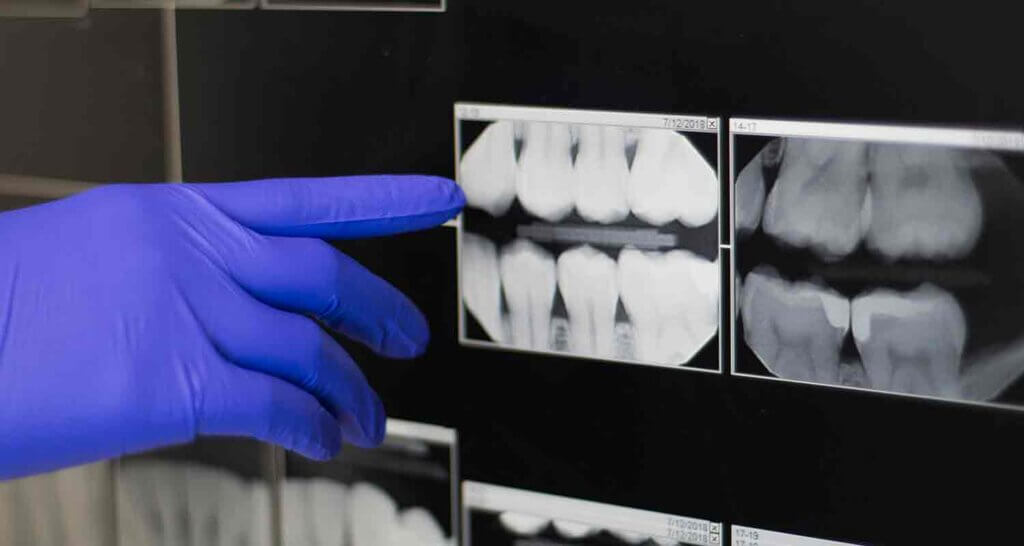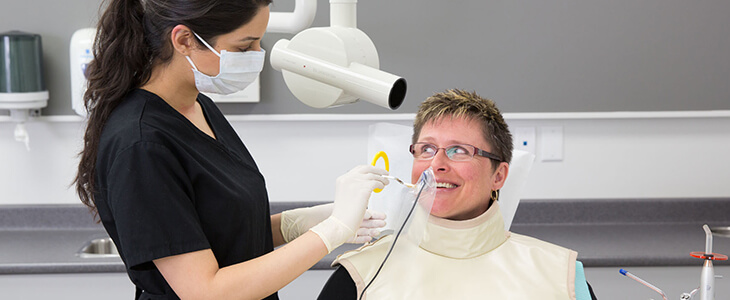Digital Dental X-Rays

What Are Digital Dental X-Rays?
Digital dental X-rays are advanced diagnostic tools that allow dentists to capture detailed images of teeth, gums, and bones using digital sensors instead of traditional film. This technology enables a more precise, efficient, and safer way to assess oral health, identifying conditions like tooth decay, gum disease, and bone issues. The digital format also allows instant access to high-resolution images that can be analyzed in real time on a computer screen.
Before you deciding on whether Digital Dental X-Rays are right for you, there are some things you should know:
- Who Needs Digital Dental X-Rays?
- Types of Digital Dental X-Rays
- Benefits Of Digital Dental X-Rays
- How Much Does Digital Dental X-Rays Cost?
- Steps In The Digital Dental X-Ray Procedure
- Frequently Asked Questions About Digital Dental X-Rays
If you have any further questions about Digital Dental X-Rays or other dental services offered at Atlas Dental, please contact us.

Free phone consultation
Have questions about CBCT Scans? Schedule a free phone consultation with our Toronto dentist.

5 star google reviews
Our patients love us! See for yourself why more and more people are choosing Atlas Dental for their CBCT Scans.

Book CBCT Scan Online
We provide quick and convenient CBCT Scan Service in Toronto. Book Online.
Who Needs Digital Dental X-Rays?
Digital X-rays are a vital part of dental care for patients of all ages and conditions. Here’s a look at different patient groups that might need digital dental X-rays:
- New Patients: During initial dental visits, digital X-rays help dentists assess the overall oral health and detect any pre-existing conditions.
- Routine Check-Ups: Adults and children alike may undergo X-rays during regular check-ups to monitor and catch any developing issues.
- Symptomatic Patients: If patients experience symptoms like pain or swelling, digital X-rays can reveal underlying issues such as decay, infection, or bone damage.
- Orthodontic Evaluation: Orthodontists use digital X-rays to analyze the jaw and teeth alignment, critical for effective treatment planning.
- Pre-Surgical Assessments: X-rays are essential for planning dental procedures like implants, extractions, or reconstructive surgery.
- Gum Disease Monitoring: Patients with gum disease may need digital X-rays to measure bone loss and assess treatment progress.
Dentists follow ALARA guidelines (As Low As Reasonably Achievable) to minimize radiation exposure, ensuring that X-rays are taken only when necessary and beneficial for diagnosis and treatment. If you have further questions about Digital Dental X-Rays, please contact us.

Types of Digital Dental X-Rays
Digital X-rays come in various types, each designed for specific diagnostic purposes:
- Intraoral X-Rays: These X-rays are captured from inside the mouth and include:
- Bitewing X-Rays: Show upper and lower teeth in one view, often used to detect cavities and examine dental restorations.
- Periapical X-Rays: Focus on the entire tooth from crown to root, helpful for detecting infections or root issues.
- Extraoral X-Rays: Captured from outside the mouth, these provide a broader view.
- Panoramic X-Rays: Offer a full view of the entire mouth, beneficial for examining jaw alignment, TMJ, and planning surgeries.
- Cephalometric X-Rays: Show a side profile, valuable for orthodontic planning.
- Cone Beam Computed Tomography (CBCT): Provides detailed 3D images of teeth, bone, and soft tissues, essential for complex cases like implant planning and oral surgery.
Each type of X-ray delivers a unique perspective on oral health, allowing dentists to build a comprehensive understanding of each patient’s needs. If you have further questions about Digital Dental X-Rays, please contact us.
Benefits Of Digital Dental X-Rays
Digital X-rays offer several benefits over traditional film-based X-rays, including:
- Lower Radiation Exposure: Digital X-rays require significantly less radiation, making them a safer option, especially for children and repeat patients.
- Instant Results: Images appear immediately on a computer screen, allowing dentists to diagnose and discuss results with patients in real-time.
- Enhanced Image Quality: Higher resolution allows dentists to zoom in, adjust contrast, and highlight specific areas, improving diagnostic accuracy.
- Environmentally Friendly: Digital X-rays eliminate the need for film and chemicals, reducing waste and being more sustainable.
- Improved Patient Education: Displaying images on a screen helps patients understand their oral health and treatment needs.
- Efficient Record-Keeping: Digital images are stored electronically, ensuring easy access for future reference or sharing with other dental specialists.
With improved diagnostic capabilities and patient engagement, digital X-rays play a vital role in ensuring comprehensive and efficient dental care. If you have further questions about Digital Dental X-Rays, please contact us.
Cost of Digital Dental X-Rays Images
The cost of Digital Dental X-Ray Images will depend on the type of image taken as well as the number of images. Example x-ray codes in the Ontario Dental Association’s Suggested Fee Guide appear as follows:
- 02111 – Single image: $41
- 02112 – Two images: $48
- 02113 – Three images: $56
- 02114 – Four images: $63
- 02115 – Five images: $74
- 02116 – Six images: $82
- 02117 – Seven images: $92
- 02141 – Single image: $41
- 02142 – Two images: $48
- 02143 – Three images: $56
- 02144 – Four images: $61
Radiographs, Regional/Localized
- 02101 – Radiographs, Complete Series (minimum of 12 images incl. bitewings): $166
- 02102 – Radiographs, Complete Series (minimum 16 images, incl. bitewings): $179
- 02601 – Single images: $84
Dental X-Rays are considered a basic service under all dental insurance plans and should be covered to your maximum insurable limit, but be sure to find out from your dental insurance plan provider how much you are eligible for before going ahead with dental treatment. Our fees are consistent with the ODA Fee Guide.
For patients without dental insurance, Atlas Dental is pleased to offer dental financing through iFinance Dentalcard. Affordable payment plans start at 7.95% for terms of 6 months to 6 years. To learn more about Dentalcard dental treatment financing, follow this link.
Steps In The Digital Dental X-Ray Procedure
The digital dental X-ray procedure is quick, comfortable, and designed to minimize radiation exposure:
- Preparation: Patients wear a lead apron and thyroid collar to protect sensitive areas.
- Image Capture: The dentist positions a small sensor in the mouth to capture the X-ray. Radiation exposure is minimal, and the process is brief.
- Immediate Viewing: Images are processed instantly and displayed on a screen for real-time analysis.
- Consultation: The dentist reviews and explains the findings to the patient, discussing any areas of concern or treatment needs.
- Storage and Follow-Up: X-ray images are saved electronically, accessible for future visits, ensuring continuity in dental care.
The digital dental X-ray procedure ensures an efficient and accurate diagnostic process for dental professionals while prioritizing patient safety and convenience. If you have further questions about Digital Dental X-Rays, please contact us.

Frequently Asked Questions About Digital Dental X-Rays
- How often should I get digital dental X-rays?
Frequency varies by individual. Healthy adults might need them every 1-2 years, while children or those at high risk may require more frequent imaging.
- Are digital dental X-rays safe during pregnancy?
Digital dental X-rays are generally considered safe during pregnancy due to their low radiation levels. However, dentists often postpone non-urgent X-rays until after pregnancy unless absolutely necessary. If an X-ray is required, protective lead aprons and thyroid collars are used to minimize exposure. Always inform your dentist if you are pregnant.
- Are digital dental X-rays painful?
No, the procedure is non-invasive and painless. Patients may experience slight discomfort when holding the sensor in their mouth.
- Do digital dental X-rays have side effects?
The radiation exposure is minimal, especially with digital X-rays, making them very safe when needed. Dentists always prioritize patient safety.
- Can digital X-rays help detect cavities?
Yes, digital X-rays are highly effective for spotting cavities, especially those that aren’t visible to the naked eye.
Digital dental X-rays are a safe and effective diagnostic tool that helps dentists identify and address oral health issues with precision. For more information or to book an appointment at Atlas Dental, please contact us

